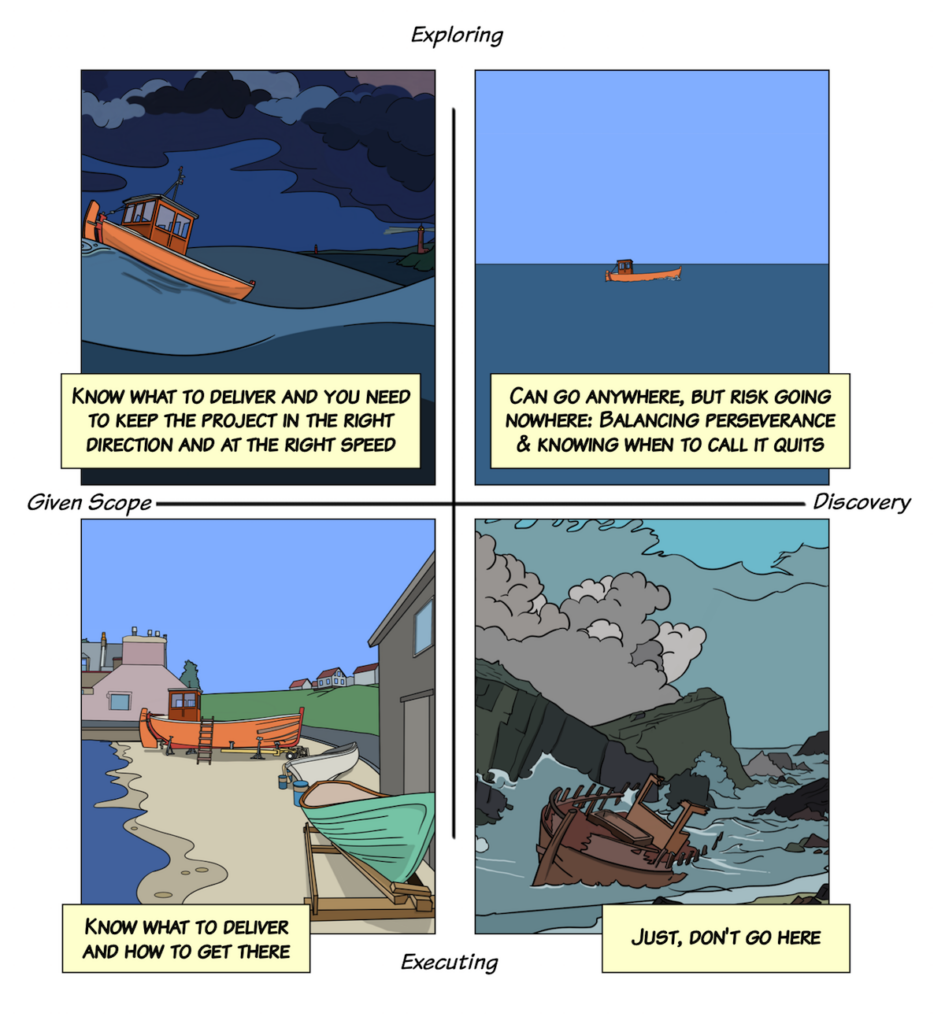This week, I wrapped up my project management series with a grand finale, tentatively titled “Mastering the Art of Project Management in a Wickedly complex word.” The idea? A deep dive into the fine art of Wicked Project Management, navigating projects in a world that is gloriously unpredictable. Or at least, that was the plan.
The audience? A room full of product and business developers, all on a noble quest for practical tools and frameworks to tame chaos, summon innovation, and, if the project gods were feeling particularly generous, deliver something on time. You know, your typical group of professionals locked in an eternal struggle with project management, whether they admit it or not.
To Give some context. This grand finale was the third and final act in a saga that began with the now-legendary Apple Pie Workshop a bit over two years ago. More on that later, but the short version? It tackled project management in the face of pure unpredictability. It was well appreciated, though, let’s be honest, the actual Dutch apple pie I baked and brought along may have played a role.
But afterward, I realized two things.
First, something was missing: a prequel covering project management fundamentals and a sequel on agile and the art of navigating truly wicked projects.
Second, I was unintentionally living out the very essence of wicked projects, ditching any sense of a linear timeline in favor of something far messier. Starting in the middle, looping back to the basics, and wrapping up with a grand flourish on wicked projects.
With the Apple Pie Workshop behind me and last year the project management fundamentals session checked off, I started preparing for a deep dive into design thinking, systems thinking, and agile development, which seemed like the perfect grand finale to refine the craft.
Alas. As with all wicked projects, where any plan or initial insight is merely a snapshot of current understanding and absolutely not a prediction of where things will end up, karma had other ideas, or maybe it was just my own common sense. But I am jumping ahead. Now, armed with the gift of hindsight, let’s rewind and start from the beginning.

The Prequel: Executing according to plan
The prequel and what should have been my first session, was a classic, structured deep dive into Project Management Fundamentals, because, believe it or not, sometimes you do know the deliverable, and, miraculously, the environment is stable.
Delivered about a year after the now-famous Apple Pie Workshop, this session dove into the PMI framework, structured project execution, stakeholder management, and the power of cross-functional collaboration. The goal? To provide a solid foundation for newcomers and a much-needed sanity check for those who’ve been around the block.
Simple templates, decision-making tools, and a few handy 2×2 matrices helped cut through the complexity. In essence, it was about how to plan, execute, and actually manage to stick to the original scope and time. Almost… relaxing.

Apple pie: Managing continuous change
But then, inevitably, reality strikes. Because what happens when the road ahead is nothing but disruption and unexpected changes? You know, the normal corporate life of any project that lasts more than a week or involves more than yourself.
Enter: The Apple Pie Workshop, where I launched into a slightly overenthusiastic analogy comparing the relative ease of baking a Dutch Apple pie (even with the occasional ingredient swap or kitchen disaster) to the far messier reality of managing large-scale business projects. Sure, one involves cinnamon, and the other involves existential dread, but somehow, the metaphor worked.
This session introduced key insights from systems thinker Russell Ackoff as a foundation for tackling the chaos that inevitably unfolds in real-world projects. We explored:
- Systems thinking – because projects don’t live in a vacuum
- Adaptability – because things will veer off course
- How to navigate unpredictability without screaming into the void (even though you’re tempted)
Let’s face it, projects don’t happen in a vacuum. Stakeholders shift their priorities, ambitions evolve, and change (or dare I say chaos) is the only true constant.

The sequel: Discovering clarity in mud
For the sequel the plan was to venture into the deep end. What if everything is clear as mud? When you can go anywhere but risk ending up nowhere?
Enter Wicked Projects, where cause and effect are outdated, and navigating a hyper-connected, multi-dimensional world feels like trying to catch shadows. A crystal-clear problem definition? Sure, but only after months of playing hide-and-seek in the solution space, testing your patience with trial after trial (and inevitable error). Traditional project management tools struggle here. Yet, somehow, these are still projects.
This session delved into:
- Agile, Lean Startup, and Design Thinking, kicking the traditional plan-and-execute phases to the curb in favor of a more modern “winging it with style.”
- How to manage shifting targets with iterative problem-solving and strategic improvisation.
- Shifting the mindset from obsessing over whether we’re on track to asking whether we’re making meaningful progress toward a goal that’s constantly evolving. In wicked projects, done is replaced by better, and good enough becomes a golden standard.
This session was bound to be the most interesting, and it hit close to home, given my years of experience in customer centric product development combined with teaching on design thinking. Yet, despite all that experience, it still took me until last Christmas to finalize the preparation (Yes, because real-world projects have an uncanny ability to derail even the most neatly planned project management presentations.)
As I prepared for three full-day sessions (or at least three intense hours) covering the full spectrum of project management, I found myself increasingly intrigued by the bigger picture, how all sections of this project management trilogy connected. And then it hit me: a 2×2 matrix was hiding beneath it all. (Yes, Tom. Of course there was)
Axis 1: The Mode of Delivery
- Plan & Execute: When the path ahead is clear, structured execution is your best bet.
- Explore & Adapt: When volatility reigns, and your best move is to keep going, even if you’re not entirely sure where you’re headed.
Axis 2: The specificity of the Deliverable
- Crystal Clear: Everyone knows exactly what success looks like.
- Clear as Mud: When defining the goal feels like an achievement in itself.
With these two axes in place, our three project management approaches fit nicely:
- Lower Left (Plan & Execute + Crystal Clear) → The fundamentals of project management, where everything is executed as planned.
- Upper Left (Explore & Adapt + Crystal Clear) → The Apple Pie Workshop Zone, where things will change, but you remain focused on delivering what’s needed.
- Upper Right (Explore & Adapt + Clear as Mud) → The Wicked Projects Zone, where progress is all about creative trial and error, adaptability, and an uncanny tolerance for existential crises.
But then there’s Lower Right. In the lower right corner we find discovery in unknown territory combined with an executing rigid project management approach. My initial reaction? Wrong! This shouldn’t exist. Can’t! And even if it would, nobody in their right mind would enter here. Useless. This must be a mistake. Let’s drop the 2×2. And I was almost, almost, prepared to finally give Tom credit. But then it clicked: this quadrant is real. It does exist, And it even has a name. Welcome to The Jira Ticket Zone.

The dark side of Project Management: The Jira Ticket Zone
The Jira Ticket Zone, the place where:
- The goal is vague, continuously morphing and changing, yet management insists on a rigid, bureaucratic process.
- Every last detail is scrutinized, with no real understanding of the bigger picture. Teams spend hours debating the estimated timeline for a minor UI tweak, while the entire product strategy falls apart behind the scenes due to shifting market forces.
Yes, this quadrant is real. And if you haven’t encountered it yet, congratulations, you’re either incredibly lucky or blissfully unaware. If you do find yourself here, run.
Modes of Control
So the 2×2 matrix made sense after all. Quite pleased with this discovery I ditched my original grand finale. and abandoned my carefully planned dissection of wicked project management. Well, not entirely. My academic roots demanded at least some semblance of structure, so I prepared a decent handout of a hundred plus (large font, illustrated) pages and handed it over to the team for self-study (a polite way of saying, “Here, read this later”), combined with being ready to dive into any details that need further exploration.
Instead, I pivoted to what I think is the Heart of It All: Modes of Control.

At the end of the day, project success isn’t just about methodologies, matrices, or meticulous planning, it’s about understanding how much control you actually have and choosing the right way to navigate it.
- Execution Mode: You have a map, a clear path, and a defined plan. Are we done yet? Your job? Stay on track and execute efficiently.
- Apple Pie Mode: You have a destination, but constant disruptions force you to adjust your pace and course-correct. Are we there yet? Success depends on mastering risk management (sequencing actions, staying ready to pivot) and managing stakeholders (sensing and adapting to evolving chaos).
- Wicked Projects Mode: There is no map. Just a sense of “better” and a process of trial and error. Are we better? Your job? Continuously assess: Is this still the right path, or is it time to pivot?
- Jira Ticket Mode: Here, we find ourselves in turbulent waters, yet rigid project management takes priority over managing change. Be aware it exists. Then do your best to avoid it.
But here’s the catch, no project fits neatly into a single mode. In reality, it’s always a mix. Some tasks run smoothly in Execution Mode, others in Apple Pie mode and then a few wickedly disrupting everything sending the team spiralling into confusion. You find yourself constantly shifting gears, like a chameleon on an espresso binge.
The real challenge? Balancing it all, executing, adapting, exploring, while dodging the straitjacket of Atlassian tools (though strategically faking Jira updates as needed). Instead of forcing order onto the madness, learn to orchestrate it, keeping momentum without derailing the whole train. Because in the end, success isn’t about choosing one approach; it’s about mastering them all to the avail of delivering, or knowing when to pivot.
.
The grand finale wasn’t about mastering every tool, framework, or acronym under the sun. We all know those, and if not, well, that’s what the handout is for. It was about how to tune your mode of control to match reality, lean, direct, and without getting lost in the weeds. Because in an increasingly complex world, the goal isn’t to eliminate chaos, but learning to navigate it with skill, adaptability, and maybe, just maybe, the occasional piece of Dutch apple pie.


Hand-out, distributed to participants: on the practice of project management, designed for product and business developers faced with the challenges of navigating fast-paced, complex, and ever-evolving project environments.

